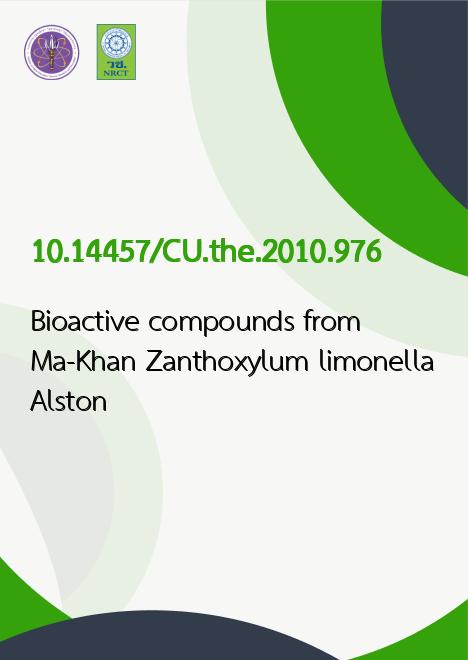
|
Bioactive compounds from Ma-Khan Zanthoxylum limonella Alston |
|---|---|
| รหัสดีโอไอ | |
| Title | Bioactive compounds from Ma-Khan Zanthoxylum limonella Alston |
| Creator | Janpen Tangjitjaroenkun |
| Contributor | Warinthorn Chavasiri, Roongtawan Supabphol |
| Publisher | Chulalongkorn University |
| Publication Year | 2553 |
| Keyword | Bioactive compounds |
| Abstract | The CH₂Cl₂ and MeOH extracts from different parts, and the essential oils of the fruits of Z. limonella were preliminarily screened for antimicrobial and antioxidant activities. The essential oil and the CH₂Cl₂ extract of the stems exhibited the most potent antimicrobial and antioxidant activities. The essential oils contained monoterpene as a major component such as sabinene (42.73%), limonene (39.05%), and terpinen-4-ol (5.40%). The essential oil and terpinen-4-ol exhibited strong activity against tested phytopathogenic fungi. In addition, the crude essential oil and sabinene possessed a broad spectrum antibacterial activity. The rate of time killing of the essential oil and sabinene appeared to be time and concentration dependent against meticillin sensitive S. aureus (MSSA), meticillin resistant S. aureus (MRSA), E. coli, and extend-spectrum β-lactamase producing E. coli (ESBL). The chromatographic separation of the CH₂Cl₂ extract of the stems led to the isolation of a new quinoline alkaloid, 4-methoxy-3-(3-methyl-2-oxobut-3-enyl)quinolin-2(1H)-one (6), along with five known compounds, (-)-asarinin (2), dihydroalatamide (4) and (-)-tembamide (7), a furoquinolone alkaloid, dictamnine (3), and a benzophenanthridine alkaloid, N-nornitidine (5). The IC₅₀, MIC, and MFC values against tested fungi of compound 3 were more potent than the CH₂Cl₂ extract of the stems. On the other hand, the MIC and MBC values of the CH₂Cl₂ extract of the stems and compound 3 were active against tested Gram-positive bacteria and yeast (C. albicans). Compound 3 was determined as a major compound and possessed the antifungal and antibacterial activities. The antioxidant capacity of the CH₂Cl₂ extract of the stems, essential oil and some isolated compounds were determined for primary antioxidative potential in cell-free system (DPPH and TEAC assay) and extended to prostate cancer cell lines, PC-3 and DU-145. The CH₂Cl₂ extract of the stems, compounds 3, 4, and 7 showed higher antioxidant capacity in cell free system than that of the essential oil of fruits and its major components. The CH₂Cl₂ extract of the stems and compounds 3, 4, and 7 seemed to act through GSH level and CAT activity. The essential oil of the fruits has high possibility of regulate CAT capacity than GSH level in both cell lines |
| URL Website | cuir.car.chula.ac.th |